“With steel you can expect to lose around 0.25 mm in thickness each year.” That was the advice I was given by a retired ship yard engineer with many years of experience behind him. We were talking about underwater corrosion on commercial steel hulls and though he felt that through regular painting this rate could be reduced a little, the life expectancy of steel work was limited by the rate at which it would naturally decay away. Of course these ideas are only generalisations and much will depend upon the environment in which a particular piece of steel is located. For example, waterlines would be expected to corrode far more quickly than the steel work beneath a well ventilated deck head. However, the idea that, come what may, steel has a natural rate of decay, has been an influence on generations of designers who have been encouraged (perhaps subconsciously) to ensure that their boats endured well by building them far thicker than strength requirements demanded. This meant that steel boats were also heavier then they need be and some designs acquired a reputation for being slow and stodgy when compared with similar hulls built from timber or glass fibre.
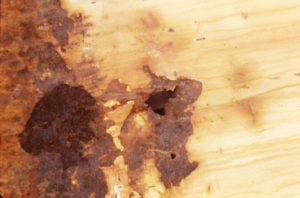
Here is a boat that rusted from the inside out. Yes, the hole goes clean through and is largely due to rusting of steel work hidden behind the interior fit out. Surely the lesson to be learned here is that if you do not have internal corrosion protection in which you can be totally confident, then the fit out should be removable for periodic inspection.
Within the last decade or so the situation has changed radically and today’s steel cruising boats are able to perform at least as well as those made from any material. The reason for the change though is not that anything has happened to the steel itself, since this rusts as well as it ever did; what is different is the indisputable improvements in the technology we have for protecting it. Not only does this include epoxy, polyurethane and polyester paints but also synthetic rubbers, metal sprayed coatings and even ceramics.
When there were just oil based paints, red lead and tar, choices were far simpler but with the range of products now available it can be extremely difficult to make a rational choice. Not a season goes by without some firm coming out with a new product that promises the latest thing in corrosion control. If nothing else, this does serve to highlight the short comings of previous products.
Manufactures are in the privileged position of having the resources and expertise to enable them to objectively assess the performance of their products compared with that of others. For the average boat owner, it is virtually impossible to obtain a truly independent, authoritative comparison of one product with another. Life is just too short to try out everything available for ourselves and so we must rely on what facts we can glean from manufacturer’s literature and the shared experiences of others we may meet. Not that this is always a reliable guide as it is not unusual for two people using the same material to achieve quite different results, and there could be many reasons for this. Maybe they interpret the manufacturer’s instructions
differently or there could be significant differences in the conditions under which they used the product. For example :
- Atmospheric conditions eg. temperature, humidity, draughts..
- Was the steel surface grit blasted and if so to what standard? If not, was there mill scale or rust present? If rust is present it could be that the conditions under which it was formed are also important. It has been suggested that rust formed in atmospheres containing sulphur dioxide or other pollutants is more persistent than rust formed in clean air.
- Was there dust present?
- How was the paint applied? (roller, brush, paint pad or spray)
- What was the paint film thickness?
- How many coats were used and what was the time between coats?
- When the boat is launched other factors affecting the performance of the finish could be:
- Time lapse between applying the finish and launching.
- The nature of the water in which the boat is used. Eg temperature, fresh, salt or containing pollutants
- Electrical environment surrounding the hull,
With so many variables at work, trying to compare different methods of protection has to be more of an art than a science.
On the whole, one might expect that the best treatment a yacht is ever likely to get will be the first that it receives in the yard in which it was built. Certainly there are horror stories of the indifferent and shoddy work some yards are capable of turning out, but in terms of experience and facilities, surely builders are better placed than most owners to exercise control over the conditions under which corrosion protections are applied. On the beach between tides, in the back garden or even in many boat repair yards, particularly those in less developed countries, conditions are far more variable. Yet in practical terms, especially if frequent maintenance is required, much will need to be carried out under less than ideal circumstances.
Like most owners of steel boats, my interest in corrosion control is sharpened whenever I see another one in a repair yard or marina. The experiences of others always has to be viewed with the above factors in mind, but to discuss with others the kind of treatments they have used is a chance to add a little to ones own ideas. On occasions I have taken photographs to add to my collection of experiences and some of these I have included later, but first let’s take a look at some of the selection of treatments available for steel
boats.
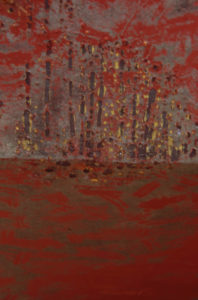
Strops can do considerable damage to paint work when the boat is lifted as they stretch and any grit they contain scours away the finish. Chine boats suffer more than round bilge and on this boat these were the only regions to show wear after a couple of years afloat. Placing heavily greased plastic sheet and cardboard behind the strops helps and if you can encourage the yard to spread the load by doubling up on the strops then so much the better.
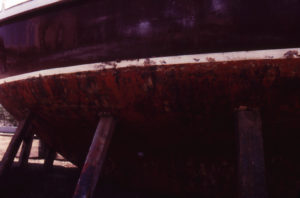 T
T
The owner of this 25 year old Dutch built steel boat informs me that it has never been blasted. After the mill scale had been removed, the original treatment was to coat it with common pitch and antifoul on top. Each year it is hauled out, any old antifoul removed and the treatment repeated. The thickness of pitch it has aquired up to now is now quite considerable On looking at it today, the pitch appeared to be well attached to the steel. The owner is quite content with this “low tech” solution and sees no reason why it should not continue for another 25 years, though pitch is becoming harder to obtain..
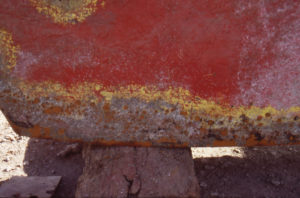
Keel bottoms can suffer greatly, particularly if you are in the habit of going aground regularly. To allow for this most are made from extra thick steel but this one is only 6mm thick and at the current rate of corrosion has not too many years left.
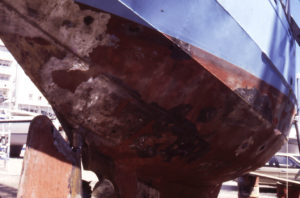
Built by the owner to his own design about 6 years ago. This boat was not blasted. Instead, surface rust and mill scale were removed by grinding and a hydrochloric acid etch. Next it was treated with a mixture of phosphoric acid/methylated spirits. After priming, topsides and interior were finished with a polyurethane which has been perfectly satisfactory but for ease of touching up the owner now prefers an ordinary enamel.
Unfortunately, in-spite of the owner being most fastidious about surface preparation, he has had difficulties in getting paint to stick below the water line. The previous paint (a Spanish epoxy tar) came away easily and in sheets, The steel work beneath was perfect, still shiny from the original grinding but rusting began as soon as it was exposed to the air.
Subsequent treatment was with Fertan and International’s Primocon. Only time will tell if this is a success
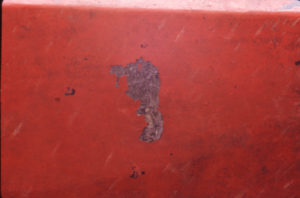
The large patch in the centre of this photograph is an area where earlier propping prevented thorough grit blasting. The paint beneath the antifoul is epoxy tar and the picture also shows a few small blisters. These are probably caused by small specks of soluble material trapped beneath the paint film which, by osmosis, are able to draw in water through the paint membrane. In most cases these are quite easily dealt with by cutting them back and retouching the area. By taking a photograph to record the positions of spot repairs of this kind, at the next haul out you you will be able to see how effective your repairs have been. or if any subsequent blisters are simply a recurrence of the old.
PRETREATMENT OF A STEEL HULL.
No corrosion protection will adhere to a hull for long whilst rust is actively forming beneath it and there can be little doubt that the most effective method of removing rust is grit blasting. There is also no doubt that it is a most unpleasant job but, none the less, one that needs to be done conscientiously, as the success of all subsequent treatment depends upon it being done well. Particular care should be taken to ensure that all black mill scale is also removed as this will encourage rusting if left behind. (The underlying steel is anodic to mill scale)
The proportion of white metal exposed by blasting is indicated by an SA index number with SA3 being the standard required for the most enduring follow up treatments. In any event the follow up treatment must be started within a very few hours of blasting and well before any moisture has a chance to condense on the surface of the steel.
Chemical rust converters.
The alternatives to grit blasting are to chip away any loose rust, followed by manual or electrically operated wire brushes, angle grinding or use of a needle gun. None are anything like as effective but your particular circumstances may leave you with no alternative.
In these cases,to make sure that any remaining rust is dealt with, some owners use a rust converter (trade names are Fertan, Trustan, Ruscon and Convertox) These are often water based solutions and do not destroy rust but convert it into an inert substance that can happily exist beneath a paint layer. I once heard it reported that they were unsuitable for marine use and I wonder if anyone has any comments on this? None of the manufacturers to whom I have put this question have replied but I have found Ruscon and and the Spanish product Convertox to be effective, particularly as a quick “holding” treatment for any small rust patches.
METAL SPRAYING
If you think grit blasting is the worst job in the world and are unfamiliar with metal spraying, the experience could be revealing. Zinc or aluminium are metals commonly used in corrosion protection and are applied immediately after grit blasting to a thickness of around 0.15mm though it can be difficult to control the exact thickness you get.
In the case of flame spraying the important piece of equipment is a gun which produces an oxygen/acetylene (or propane) flame that continuously melts a zinc or aluminium wire fed through the back of the unit. The gun is also connected to a compressor and this is used to supply a blast of air which breaks up the molten metal into a fine spray that is directed on to the work.
The bond between a zinc spray coat and steel is good but on occasions this is over coated with aluminium, which on its own forms a relatively weak bond with the steel, tending to break away from edges. Arc spraying is an alternative process frequently used for aluminium and here the metal is melted through an electric arc rather than a flame.
The cost of the equipment makes metal spraying an expensive process and one that is usually only undertaken by specialist contractors. However, its benefits are great and if a yacht’s topsides have been metal sprayed, any paint chipping knocks or bangs will not immediately start to rust, though I am not too convinced of the value of zinc spray on submerged steel work,
In the case of my own boat I was fortunate enough to find a local firm who, at reasonable cost, were able to help with blasting and zinc spraying the hull both inside and out. On the whole I have every reason to be thankful for the job done, particularly as the bilge and regions of the boat where corrosion frequently starts, still appears as sound as the day it was done.
If you want to use zinc but without metal spraying, there are several one and two part (epoxy) based high zinc paints on the market. These can be used instead but the strength of the bond they make with the steel will not be as great.
PAINTS.
The most versatile economic and familiar way of protecting steel is by painting it. To get the most enduring results from metal sprayed steel, overcoating with paint is undoubtedly a good idea. Here we will look at some of the more popular high performance finishes.
Epoxy paints.
Well known for producing a hard enduring finish, these are more suitable as as primers and undercoats rather than high gloss finishes. This is because after a few months exposure they often squire a chalky appearance.
As with all modern finishes it is important to follow the manufacturer’s recommendations, particularly on the time that may lapse between coats. Once fully cured it is often difficult to get subsequent coats of paint to stick. Use of an abrasive to roughen the surface to produce a key that will physically bond to the next layer is the only answer.
Polyurethanes.
Like epoxies, polyurethanes are similarly hard, enduring and difficult to get a second coat to stick to a fully cured previous layer. Unlike epoxies, they will maintain a good gloss finish over a longer period and this makes them suitable for the final coat of a multi coat protection system. Polyurethane paints appear to store well but after a few months, partially used tins of their hardeners often set solid.
Epoxy Tar
(Sometimes called Tar epoxy, epoxy pitch or pitch epoxy)
Epoxy tars have been around for many years and are well known as one of the best treatments for underwater steel and any part of the boat where appearance is not greatly important. They are used extensively as an industrial finish and as such do not attract the “marine” premium of similar materials supplied specifically for yachts.
Epoxy tar can be applied directly to blasted steel but is not always successful on steel where this has not been carried out. Around 4 coats are required to give a thickness of 400 microns (that’s about the thickness of 6 pages of PBO) which is the minimum needed to set up an enduring barrier layer.
However, epoxy tars do vary considerably between different suppliers and because of this it is particularly important to take note of the manufacturer’s advice. Some cure faster and harder, and some are described as “high solids” which implies that a large proportion of the paint will set rather than evaporate away as solvent.
Chlorinated rubbers.
These are a firm favourite of mine and unlike those already mentioned, chlorinated rubbers are one part paints. They are relatively inexpensive, resistant to diesel oil, paraffin and many corrosive chemicals. They adhere well to previous coats and can be successfully applied in conditions of damp and cold that would be impossible with epoxies or polyurethanes. Matt high build and gloss finishes are available and in the UK these can be supplied in a wide selection of colours. As with Epoxy tar, these paints are thined with xylene but other solvents are often included to make them more suitable for spray or brush application.
Many countries use chlorinated rubber paint for road markings. These grades usually dry to a matt finish. and the colours are of course a bit limited.
On the negative side I have to admit that chlorinated rubbers are nowhere near as hard as epoxies or polyurethanes and are sensitive to certain solvents. These include acetone, tuna fish oil and, I am reliably informed, sun tan lotion and vomit.
LIMPETITE.
Now here’s an interesting product and one that’s seldom mentioned in the yachting press, probably because its main markets are in corrosion protection for specialist parts of large ships and power station sea water inlets.
My first encounter with it was about 10 years ago when I visited the manufacturers in Bristol*. There, in one of their workshops, I found a painter armed with a tiny brush on the end of a very long stick (sometimes known as a “radiator brush”). He was carefully applying about a dozen coats of Limpetite to the insides of some very long steel pipes. They were destined for a new power station where they would carry sea water and remain buried in concrete for the life of the station. Maintenance would be impossible but unlikely to be needed as similar pipes treated in this way some 36 years ago were still giving good service. I was also shown some limpetite coated parts still in excellent condition after this length of service and I wonder how many manufacturers of modern paint systems could demonstrate a similar claim.
However, limpetite is best described as a synthetic rubber coating rather than a paint, though like a paint it is often applied by brushing. This not withstanding, there are many important differences that the manufacturers point out in their literature and failure of users to take note has not encouraged them to promote the product on amateur markets.
At the time I was building my boat I felt unprepared to commit the whole hull to a product with which I was unfamiliar but was keen to try Limpetite and so decided to treat the rudder as a test patch. 6 years later I decided to strip it off. The reason for this was that the coating had sustained some accidental minor damage and the cost of having replacement material sent to the country I was in was prohibitive. I was also curious to see what was happening underneath and how difficult it would be to remove. The pics below show the results.
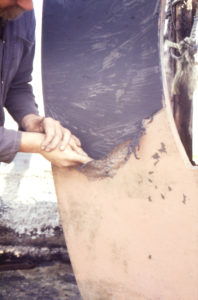 I used the rudder on my boat as a test patch for limpetite and could see no reason to doubt any of the manufacturer’s claims. After 6 years it was still very flexible, bonded extremely well to the steel and certainly did not allow any corrosion to take place underneath. Were it not for some accidental damage I could see no reason why it should not have continued in place for many more years
I used the rudder on my boat as a test patch for limpetite and could see no reason to doubt any of the manufacturer’s claims. After 6 years it was still very flexible, bonded extremely well to the steel and certainly did not allow any corrosion to take place underneath. Were it not for some accidental damage I could see no reason why it should not have continued in place for many more years
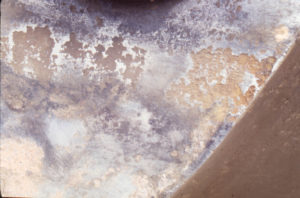
My Preferred Treatment
Of the treatments I have tried, my preference is grit blasting to SA3, then flame spraying with zinc all surfaces that are not to be permanently submerged. These I would give at least 4 coats of epoxy tar and allow about 2 weeks before launching for solvents to escape and the epoxy to cure thoroughly. (To ensure good adhesion, antifoul must be applied to some grades of epoxy tar before it is fully cured) For zinc sprayed surfaces, my favourite treatment is to apply a good coat of Dacrylate 2ZP #(a two part epoxy anti corrosive primer) and for the bilge and interior surfaces I would follow this up with 3 coats of epoxy tar. On topsides, I would overcoat the primer with one coat of high build and one coat of gloss chlorinated rubber paint.
A common fallacy with steel boats is that if you sustain any damage its going to be really easy to patch up. Certainly, major advantages are that it is cheap and easy to weld great strength into damaged sections, but this is only part of the story. The finished repair will need corrosion protection to a standard matched by the remainder of the boat and this may mean grit blasting and metal spraying. Particularly if this is needed inside the boat, the work will be considerable.
It may be delamination, osmosis or gribble – all boat building materials have their limitations. None are totally maintenance free, but given a good start in life with a conscientiously applied corrosion protection system, steel boats need no more maintenance than those made from glass fibre or any other material.
# Dacrylate paints are available from :
Clifton Paints Ltd., 92-100 North Street, Bedminster, Bristol. BS3 1HF
* Protective Rubber Coatings (Limpetite) Ltd., Paynes ship yard Coronation Road, Bristol.
—–OOO—–